Association studies for yield and its component traits in Basmati genotypes of Himachal Pradesh, India
Bạn đang xem bản rút gọn của tài liệu. Xem và tải ngay bản đầy đủ của tài liệu tại đây (364.41 KB, 7 trang )
Int.J.Curr.Microbiol.App.Sci (2018) 7(3): 1243-1249
International Journal of Current Microbiology and Applied Sciences
ISSN: 2319-7706 Volume 7 Number 03 (2018)
Journal homepage:
Original Research Article
/>
Association Studies for Yield and Its Component Traits in Basmati
Genotypes of Himachal Pradesh, India
Vinod Kumar1* and Dhirendra Singh2
1
Department of Crop Improvement (Plant Breeding and Genetics), CSK, HP, Krishi
Vishvavidyalaya, Palampur-176062 (H.P.), India
2
Hill Agricultural Research and Extension Centre Dhaulakuan, CSK, HP, Krishi
Vishvavidyalaya, (H.P.), India
*Corresponding author
ABSTRACT
Keywords
Basmati rice, Correlation
coefficients, Path
coefficient analysis,
Residual effect
Article Info
Accepted:
10 February 2018
Available Online:
10 March 2018
An experiment was carried out with 30 basmati genotypes including 3 checks, were raised
in randomized block design with three replications, to determine the inter-relationships
among yield components and their direct and indirect contributions towards seed yield.
The genotypic correlation coefficients were higher in magnitude than phenotypic
correlation coefficients which revealed a strong inherent association between various
characters under study and the phenotypic expression of correlations was lessened under
the influence of environment. Grain yield per plant had a significantly positive correlation
with spikelet per panicle, grains per panicle and fertility per cent. Grain length had positive
and significant correlation with grain length after cooking, grain breadth and L: B ratio
indicating typical basmati character that basmati varieties elongate length wise. Path
analysis revealed that grains per panicle had a maximum direct effect on grain yield per
plant followed by tillers per plant and 1000-grain weight. Therefore selection based on
these characters either in combination or alone will help in improving basmati cultivars.
Introduction
Rice (Oryza sativa L.) is one of the major
staple food crop of world especially of the
most Asian countries like China, India,
Pakistan, Bangladesh Vietnam and Korea.
Rice is placed on second position in cereal
production around the globe. More than 90%
of the world’s rice is grown and consumed in
Asia, where 60% of the world’s population
lives. Rice accounts for between 35-60% of
the caloric intake of three billion Asians. In
India rice was grown on an area of 43.38
million hectares with a production of 104.32
million tonnes (Anonymous 2016). In
Himachal Pradesh rice is a major kharif crop,
next to maize and occupied an area of 72.5
thousand hectares with a production of 125.2
thousand tones with productivity of 17.3 q/ha
(Anonymous 2016). Scented rice (Basmati)
are known for their fine grains and cooking
quality which includes longer and slender
grain, higher grain elongation after cooking,
low
gelatinization
temperature
and
intermediate amylose content. These quality
characteristics coupled with high aroma add to
1243
Int.J.Curr.Microbiol.App.Sci (2018) 7(3): 1243-1249
the value of basmati rice. In Himachal
Pradesh, basmati rice is grown in a few
isolated areas and the farmers mostly grow
local cultivars which warrant development of
high yielding scented rice varieties suitable for
cultivation. Seed yield is a complex character
which is highly influenced by interaction of
various component traits and the environment.
Therefore knowledge on nature of associations
between yield and its component characters
and their direct and indirect contributions on
seed yield is necessary for efficient selection
(Robinson et al., 1951). However when more
characters are included in correlation study,
the association become complex and
correlation coefficient alone does not provide
exact picture of relative importance of
different characters and their direct and
indirect influence on yield. In such situations,
selection on the basis of direct and indirect
effects is much more useful, using path
analysis. Hence, the present investigation was
undertaken to study the association among
grain yield and its component characters along
with the nature and extent of direct and
indirect effects of yield components on the
grain yield in basmati rice.
Materials and Methods
The present investigation was carried out with
thirty genotypes of aromatic rice including
three checks T-23, Hassan Serai and Kasturi
(Table 1) in a randomized block design with
three replications having a plot size of 3.0m ×
1m, inter-row and inter-plant spacing of 20cm
and 15cm respectively, at Rice and Wheat
Research Centre, Malan during Kharif, 2013.
All recommended cultural practices were
followed to raise the experiment. Observations
were taken from five random plants from each
genotype and each replication on on characters
such as days to 50 per cent flowering, plant
height (cm), tiller per plant (cm), panicle
length (cm), spikelet per panicle, fertility
percent, grains per panicle, 1000 grain weight
(gm), grain yield per plant (gm) grain length
(mm), grain width (mm), grain L/B ratio, grain
length after cooking (mm), elongation ratio,
amylose
content
(%),
gelatinization
temperature (1-7 scale). In order to determine
the
inter-relationships
among
yield
components and their direct and indirect
contributions towards seed yield, correlation
coefficients were calculated as per Al-Jibouri
et al., 1958 and path coefficient were
estimated as per Dewey and Lu, 1959.
Results and Discussion
The magnitude and nature of association of
characters at genotypic and phenotypic levels
are presented in table 2. In general, the
estimates of genotypic correlation were higher
in magnitude than the phenotypic correlation
coefficient, indicating a fairly strong inherent
interrelationship among the traits. At
phenotypic and genotypic level, grain yield
per plant had significant and positive
correlation with spikelets per panicle
(rp=0.5133; rg=0.5761), grains per panicle
(rp=0.5762; rg=0.6310), and fertility per cent
(rp=0.2124;
rg=0.2199)
and
negative
correlation with days to 50 % flowering (rp=0.2084; rg=-0.2400). These results were in
consonance with the earlier reports of
Sangeeta et al., (2001), Adil et al., (2007)
Nayak et al., (2007), Akhtar et al., (2011),
Bagati et al., (2016), Dhurai et al., (2016) and
Behra et al., (2017) for grains per panicle and
fertility per cent. It was observed that plant
height was positively and significantly
correlated with panicle length (rp=0.5019;
rg=0.5431), spikelets per panicle (rp=0.2797;
rg= 0.2950), grains per panicle (rp=0.2813;
rg=0.2815), L: B ratio (rp=0.3434;
rg=0.3813), amylose content (rp=0.2864;
rg=0.3000) and gelatinization temperature
(rp=0.2806; rg=0.3251). Panicle length had
significant and positive correlation with
spikelets per panicle (rp=0.4935; rg=0.5523),
grains per panicle (rp=0.4581; rg=0.5175),
1244
Int.J.Curr.Microbiol.App.Sci (2018) 7(3): 1243-1249
grain length (rp=0.3035; rg=0.3607) and L: B
ratio (rp=0.3209; rg=0.3771). Spikelets per
panicle was significantly and positively
correlated with grains per panicle (rp=0.9066;
rg=0.9177),
grain
length
(rp=0.2171;
rg=0.2226), and L: B ratio (rp=0.3687;
rg=0.3908). Significant positive correlation of
grains per panicle was noticed with fertility
per cent (rp=0.3050; rg 0.2932) and L: B ratio
(rp=0.3474; rg=0.3828). Fertility per cent
showed significantly positive correlation with
elongation ratio (rp=0.2415; rg=0.2738) and
amylose content (rp=0.2472; rg=0.2713).
1000-grains weight was significantly and
positively correlated with grain length
(rp=0.6870; rg=0.7565), grain breadth
(rp=0.6734; rg=0.7090) and grain length after
cooking (rp=0.2903; rg=0.3177). Among the
quality traits, grain length exhibited
significantly positive association with grain
length after cooking (rp=0.3566; rg=0.3664),
grain breadth (rp=0.4873; rg=0.5193) and L: B
ratio (rp=0.4057; rg=0.3580).
Similar results were obtained by Zahid et al.,
(2006) for association between grain length
and grain length after cooking, which is the
typical basmati character as basmati varieties
elongate length wise after cooking. L: B ratio
had significantly positive correlation with
grain length after cooking (rp=0.2350;
rg=0.2322). Grain length after cooking was
significantly and positively correlated with
elongation ratio (rp=0.6888; rg=0.7041).
Table.1 List of materials used in the study
Sr. No.
1
2
3
4
5
6
7
8
9
10
11
12
13
14
15
16
17
18
19
20
21
22
23
24
25
26
27
28
29
30
Designation
HPR 2610
HPR 2612
HPR 2667
HPR 2668
HPR 2692
HPR 2693
HPR 2694
HPR 2695
HPR 2696
HPR 2746
HPR 2747
HPR 2748-W
HPR 2749
HPR 2751
HPR 2753
HPR 2754
HPR 2755
HPR 2757
HPR 2761
HPR 2850
HPR 2853
HPR 2854
HPR 2855
HPR 2857
HPR 2861
HPR 2863
Sharbati
T-23
Hassan Serai
Kasturi
Parentage/Source
Hassan Serai /T 23//IR 66295-36-2
Hassan Serai /T 23//IR 66295-36-2
Palampur Purple/ Kasturi
Palampur Purple/ Kasturi
Hassan Serai/T 23//IR 67011
Hassan Serai /T 23//IR 66295-36-2
Hassan Serai /T 23//IR 66295-36-2
Hassan Serai /T 23//IR 66295-36-2
Hassan Serai /T 23//IR 66295-36-2
Hassan Serai /T 23//IR 67011
Hassan Serai /T 23//IR 66295-36-2
Hassan Serai /T 23//IR 66295-36-2
Hassan Serai /T 23//IR 66295-36-2
Hassan Serai /T 23//IR 66295-36-2
Hassan Serai /T 23//IR 66295-36-2
Hassan Serai /T 23//IR 66295-36-2
Hassan Serai /T 23//IR 66295-36-2
Hassan Serai /T 23//IR 66295-36-2
Hassan Serai/ Kasturi
T 23/ Kasturi
T 23/ Kasturi
T 23/ Kasturi
T 23/ Kasturi
T 23/ Kasturi
Palampur Purple/ Kasturi
Palampur Purple/ Kasturi
FRR 843-3/IR 38784-137-2-5//FRR843-3/IR 38787-26-2-2-3
Pure line selection from a local cultivar
Introduction from Iran
Basmati 370/CRR 88-17-15
1245
Int.J.Curr.Microbiol.App.Sci (2018) 7(3): 1243-1249
Table.2 Estimates of phenotypic (P) and genotypic (G) correlation coefficient among different characters in basmati genotypes
Traits
Days to
50%
flowering
Plant
height
Tillers/
plant
Panicle
length
Spikelets
per
panicle
Grains
per
panicle
Fertility
1000grains
weight
Grain
length
Grain
breadth
L:B
ratio
Grain
length
after
cooking
Elongati
on ratio
Amylose
content
GT
0.1350
0.0566
0.0767
-0.0123
0.0151
-0.0169
0.1103
-0.0865
Yield
/plant
rp
-0.2084*
0.1086
0.1130
0.1124
0.5133*
0.5762*
0.2124*
rg
-0.2400*
0.0744
0.1419
0.1599
0.5761*
0.6310*
0.2199*
0.1462
0.0194
0.0856
-0.0553
0.0051
0.0067
0.1263
-0.1059
Days to
50%
flowering
Plant
height
rp
0.0122
0.0824
0.1528
-0.0170
-0.1447
-0.3809
-0.2843*
-0.1680
-0.0903
-0.0524
-0.1229
0.0043
-0.1047
0.0095
rg
0.0197
0.0755
0.1523
-0.0169
-0.1519
-0.4357
-0.3048*
-0.1838
-0.0970
-0.0561
-0.1409
-0.0062
-0.1096
0.0106
rp
-0.1408
0.5019*
0.2797*
0.2813*
0.0505
-0.0230
0.1162
-0.2110*
0.3434*
0.1032
0.0060
0.2864*
0.2806*
rg
-0.2127*
0.5431*
0.2950*
0.2815*
0.0190
-0.0201
0.1204
-0.2324*
0.3813*
0.1096
0.0105
0.3000*
0.3251*
Tillers per
plant
rp
-0.2112*
-0.3628*
-0.2915*
0.1167
-0.3825
-0.4040*
-0.0344
-0.3418*
-0.1510
0.1598
-0.0403
-0.1602
rg
-0.3222*
-0.4901*
-0.3886*
0.2025
-0.4746
-0.5678*
-0.0620
-0.4619*
-0.2072*
0.2115
-0.0631
-0.1678
Panicle
length
rp
0.4935*
0.4581*
-0.0624
0.1687
0.3035*
-0.0333
0.3209*
0.1781
-0.0709
0.0454
0.0144
rg
0.5523*
0.5175*
-0.0627
0.1651
0.3607*
-0.0284
0.3771*
0.1941
-0.0947
0.0320
0.0287
Spikelets
per panicle
rp
0.9066*
-0.1063
0.0686
0.2171*
-0.1434
0.3687*
0.0056
-0.1504
0.0070
0.1248
rg
0.9177*
-0.0987
0.0755
0.2226*
-0.1509
0.3908*
-0.0057
-0.1638
0.0100
0.1374
Grains per
panicle
rp
0.3050*
-0.0691
0.0356
-0.2869*
0.3474*
-0.0527
-0.0663
0.0862
0.0993
rg
0.2932*
-0.0691
0.0430
-0.3016*
0.3828*
-0.0582
-0.0776
0.0879
0.1019
Fertility
rp
-0.2670*
-0.4225*
-0.3209*
-0.0594
-0.0903
0.2415*
0.2472*
-0.0241
rg
-0.3041*
-0.4519*
-0.3543*
-0.0415
-0.0758
0.2738*
0.2713*
-0.0466
1000grains
weight
Grain
length
rp
0.6870*
0.6734*
-0.0756
0.2903*
-0.2421*
-0.1861
-0.1099
rg
0.7565*
0.7090*
-0.0753
0.3177*
-0.2563*
-0.1927
-0.1252
rp
0.4873*
0.4057*
0.3566*
-0.4297*
-0.1265
-0.0198
rg
0.5193*
0.3580*
0.3664*
-0.4014
-0.1334
-0.0009
Grain
breadth
rp
-0.5987*
0.0889
-0.2833*
-0.2070
-0.1757
rg
-0.6107*
0.1002
-0.2896*
-0.2195*
-0.1781
L:B ratio
rp
0.2350*
-0.0954
0.1043
0.1808
rg
0.2322*
-0.0520
0.1203
0.2100*
Grain
length after
cooking
Elongation
ratio
rp
0.6888*
-0.1244
-0.0826
rg
0.7041*
-0.1268
-0.0903
rp
-0.0235
-0.0674
rg
-0.0242
-0.0904
Amylose
content
rp
-0.0285
rg
-0.0244
* Significant at 5% level of significance
1246
Int.J.Curr.Microbiol.App.Sci (2018) 7(3): 1243-1249
Table.3 Direct and indirect effects of component traits on yield at phenotypic at phenotypic and genotypic level
Days to
50%
flowering
Traits
Plant
height
Tillers
per
plant
Panicle
length
Spikelet
per
panicle
Grains
per
panicle
Fertility
per cent
1000grains
weight
Grain
length
Grain
breadth
L:B
ratio
Grain
length
after
Elongati
on ratio
Amylose
content
G.T.
Yield
per
plant
Days to 50%
flowering
rp
0.057
0.001
0.039
-0.054
0.013
-0.247
0.124
-0.117
0.346
-0.184
-0.096
-0.068
-0.002
-0.019
-0.001
-0.208*
rg
0.000
0.089
-0.037
0.038
-0.542
0.517
-0.242
-0.832
-0.089
-0.052
0.946
-0.044
-0.053
0.002
-0.241*
Plant height
rp
0.058
0.001
0.067
-0.067
-0.177
-0.213
0.481
-0.016
-0.009
-0.242
-0.433
0.629
0.057
0.000
0.052
-0.019
0.111
rg
0.001
-0.020
-0.251
-0.132
-0.671
1.004
-0.023
-0.016
0.549
-0.215
0.347
-0.734
0.039
0.144
0.050
0.072
Tillers per
plant
rp
0.005
-0.009
0.476
0.074
0.277
-0.498
-0.038
-0.157
0.836
-0.076
-0.623
-0.083
-0.073
-0.007
0.011
0.115
rg
0.004
0.004
1.179
0.078
1.115
-1.386
-0.240
-0.377
-2.575
-0.055
-0.421
1.379
1.492
-0.030
-0.026
0.141
Panicle length
rp
0.009
0.033
-0.101
-0.352
-0.377
0.783
0.020
0.069
-0.628
-0.072
0.588
0.099
0.033
0.008
-0.001
0.111
rg
0.009
-0.011
-0.380
-1.257
1.846
0.074
0.131
1.637
-0.028
0.343
-1.297
-0.686
0.015
0.004
0.158
Spikelet per
panicle
rp
-0.001
0.019
-0.173
-0.242
-0.174
-0.763
1.550
0.035
0.028
-0.448
-0.298
0.675
0.003
0.069
0.001
-0.008
0.515*
rg
-0.001
-0.006
-0.578
-0.134
-2.276
3.274
0.117
0.060
1.010
-0.142
0.356
0.034
-1.164
0.005
0.021
0.576*
Grains per
panicle
rp
-0.008
0.019
-0.139
-0.161
-0.692
1.709
-0.099
-0.028
-0.072
-0.597
0.635
-0.029
0.030
0.016
-0.007
0.577*
rg
-0.009
-0.006
-0.458
-0.125
-2.088
3.568
-0.348
-0.055
0.193
-0.284
0.348
0.386
-0.549
0.042
0.016
0.631*
rp
-0.022
0.003
0.056
0.022
0.081
0.521
-0.325
-0.110
0.875
-0.664
-0.111
-0.050
-0.110
0.045
0.002
0.213*
rg
-0.025
0.000
0.239
0.015
0.225
1.046
-0.241
-2.056
-0.333
-0.038
0.509
1.945
0.131
-0.007
0.222*
1000-grains
weight
rp
-0.016
-0.002
-0.182
-0.059
-0.052
-0.118
-1.188
0.087
0.411
-1.421
1.385
-0.139
0.161
0.107
-0.034
0.007
0.135
rg
-0.018
0.000
-0.560
-0.040
-0.172
-0.247
0.361
0.793
3.433
0.661
-0.069
-2.119
-1.768
-0.093
-0.019
0.143
Grain length
rp
-0.010
0.008
-0.193
-0.107
-0.166
0.060
0.137
0.283
-2.068
0.999
0.743
0.198
0.194
-0.023
0.001
0.056
rg
0.039
0.048
-0.619
-0.037
-0.456
0.401
0.788
0.650
0.389
0.532
0.576
-0.950
-1.326
-0.014
0.000
0.021
rp
-0.005
-0.014
0.082
0.012
0.311
-0.297
0.305
0.477
-0.805
0.354
-0.698
0.248
0.128
-0.038
0.011
0.071
rg
-0.006
0.005
-0.069
0.057
0.347
-1.037
0.424
0.563
2.353
-0.557
-0.654
-1.99
-0.056
-0.027
0.084
rp
0.047
0.073
-0.112
-0.063
-0.031
0.843
0.070
0.019
-0.589
0.731
-1.181
0.331
0.380
0.094
0.069
0.038
-0.012
rg
-0.003
-0.007
-0.495
-0.091
-0.839
1.415
0.050
-0.060
1.673
-0.569
-1.549
-0.329
0.108
0.032
-0.054
Grain length
after cooking
rp
-0.007
0.007
-0.072
-0.013
-0.005
-0.090
0.029
0.119
-0.689
0.178
0.610
0.430
0.403
-0.260
-0.022
0.005
0.013
rg
-0.008
-0.002
-0.244
-0.047
0.012
-0.206
0.091
0.252
1.667
0.091
0.211
-6.674
4.939
-0.061
-0.014
0.007
Elongation
ratio
rp
0.000
0.000
0.077
0.026
0.116
-0.114
-0.080
-0.098
0.890
-0.584
-0.179
0.380
-0.451
-0.005
0.005
-0.017
rg
0.000
0.050
0.300
0.524
0.877
0.221
-0.279
0.300
-1.325
-0.220
0.001
-1.439
0.530
-0.015
0.485
0.010
Amylose
content
rp
-0.006
0.019
-0.019
-0.016
-0.005
0.147
-0.080
-0.077
0.259
-0.428
0.190
-0.069
0.014
0.180
0.002
0.111
rg
-0.006
-0.006
-0.074
-0.008
-0.023
0.314
-0.322
-0.153
-0.599
-0.206
0.109
0.847
-0.224
-0.004
0.127
G.T.
rp
0.001
0.019
-0.076
-0.005
-0.095
0.170
0.008
-0.045
0.044
-0.352
0.332
-0.046
0.032
0.482
-0.005
-0.066
-0.084
rg
0.001
-0.006
-0.198
-0.007
-0.313
0.364
0.055
-0.099
-0.012
-0.161
0.192
0.602
-0.666
-0.012
0.154
-0.106
Fertility
Grain breadth
L:B ratio
Significant at 5% level of significance
Residual effect: Phenotypic =0.362
Genotypic = 0.180
1247
Int.J.Curr.Microbiol.App.Sci (2018) 7(3): 1243-1249
Seed yield is a complex character which is
highly influenced by interaction of various
component traits and the environment.
Compartmentalization
of
correlation
coefficients into direct and indirect effects
revealed the true nature of associations
observed among various characters. The path
coefficient analysis
using phenotypic
correlation coefficients among pair of
characters depicting direct and indirect effects
on seed yield showed the highest positive
direct effect of grains per panicle (rp= 1.709;
rg= 3.568) followed by tillers per plant
(rp=0.476; rg= 1.179) and 1000-grains weight
(rp= 0.411; rg=0.793) at both phenotypic and
genotypic level (Table 3). Concurrently,
spikelets per panicle had indirect effect on
grain yield via grains per panicle and L: B
ratio at both phenotypic and genotypic level.
Grains per panicle had indirect effect on grain
yield via L: B ratio. At phenotypic level
fertility per cent had indirect effect on grain
yield via grains per panicle and grain length.
At genotypic level fertility per cent had
indirect effect on grain yield via grains per
panicle and elongation ratio. In the present
study, grains per panicle had direct effect on
grain yield at phenotypic and genotypic level
coupled with high positive correlation. The
path coefficient analysis carried out at a
phenotypic and genotypic levels showed
similar trend in majority of traits. At both
genotypic and phenotypic levels grains per
panicle, tillers per plant, 1000-grains weight
had highest positive direct effect on yield. So
grains per panicle is an important parameter
as it exhibit the high positive direct effect on
yield at both genotypic and phenotypic levels
coupled with high positive correlation and
moderate to high value of residual effect.
Similar results were obtained by Gravois and
Helms (1992), Gazafrodi et al., (2006), Agahi
et al., (2007) and Ritu (2008) as they also
reported that grains per panicle and grain
weight had positive direct effect on grain
yield. Hossain et al., (2015) reported that
effective tillers per plant had the positive
direct effect on grain yield per plant followed
by grains per panicle which is in accordance
to present study.
From the present study it is concluded that
spikelets per panicle, grains per panicle, and
fertility percent showed positive and
significant association with grain yield and
also among themselves. Path analysis
revealed that grains per panicle had a
maximum direct effect on grain yield per
plant followed by tillers per plant and 1000grain weight. Therefore simultaneous
selection for these characters would result in
improvement of yield. The genotypic (0.180)
and phenotypic (0.362) residual effect were
considerably low indicating the significant
contribution of the characters taken for study
towards yield per plant.
References
Adil, J., Muhammad, A., Ejaz, A and Zadid,
M.A. 2007. Genotypic and phenotypic
correlation among various plant traits in
rice hybrids (Oryza sativa L.). Science
International Lahore 19(1): 287-290.
Agahi, K., Fotokian, M.H and Farshadfar, E.
2007. Correlation and path coefficient
analysis for some yield related traits in
rice genotypes (Oryza sativa L). Asian
Journal of Plant Sciences 6: 513-517.
Akhtar, N., Nazir, M.F., Rabnawaz, A.,
Mahmood, T., Safdar, M.E., Asif, M
and Rehman, A. 2011, Estimation of
heritability, correlation and path
coefficient analysis in fine grain rice
(Oryza sativa L.), The Journal of
Animal and Plant Sciences, 21(4):660664
Al-Jibouri, H.A., Millar, P.A and Robinson,
H.P.
1958.
Genotypic
and
environmental variance and co-variance
in upland cotton cross of inter-specific
origin. Agronomy Journal 50: 633-636.
1248
Int.J.Curr.Microbiol.App.Sci (2018) 7(3): 1243-1249
Anonymous. 2016. Food and Agriculture
Organization; .
Anonymous. 2016. Statistical Outline of
Himachal Pradesh 2015-16. Department
of Economics and Statistics, Directorate
of land records, Government of
Himachal Pradesh.
Bagati, S., Singh, A.K., Salgotra, R.K.,
Bhardwaj, R., Sharma, M., Rai, S.K and
Bhat, A. 2017. Genetic variability,
heritability and correlation coefficients
of yield and its component traits in
basmati rice (Oryza sativa L.). SABRAO
Journalof Breeding and Genetics 48
(4): 445-452
Behera, M., Monalisa, S.P., Bastia, D.N and
Kulkarn, CC. 2017. Correlation and
Path Analysis Studies in Aerobic Rice.
International Journal of Current
Microbiology and Applied Sciences
6(8): 2851-2856
Dewey, D.R and Lu, K.H. 1959. A correlation
and path analysis of components of
crested wheat grass seeds population.
Agronomy Journal 51(8): 515-518.
Dhurai, S.Y., Reddy, D.M and Ravi, S. 2016.
Correlation and path analysis for yield
and quality characters in rice (Oryza
sativa L.). Rice Genomics and Genetics
7(4): 1-6
Gazafrodi, A.A., Honarnegad, R., Fotokian,
M.H and Alami, A. 2006. Study of
correlations among agronomic traits and
path analysis in rice (Oryza sativa L).
Journal of Science and Technology of
Agriculture and Natural Resources 10:
99-107.
Gazafrodi, A.A., Honarnegad, R., Fotokian,
M.H and Alami, A. 2006. Study of
correlations among agronomic traits and
How to cite this article:
path analysis in rice (Oryza sativa L).
Journal of Science and Technology of
Agriculture and Natural Resources 10:
99-107
Gravois, K.A and Helms, R.S. 1992. Path
analysis of rice yield and yield
components as affected by seedling rate.
American Society of Agronomy Journal
84(1): 1-4.
Hossain, S., Haque, M.M.D and Rahman, J.
2015. Genetic variability, correlation
and path coefficient analysis of
morphological traits in some extinct
local aman rice (Oryza sativa L.).
Journal of Rice Research 4(1): 1-7
Nayak, A.R. 2007. Heritability and
correlation in scented rice. Indian
Agriculturist 51(1): 9-12
Ritu.
2008.
Genetic
analysis
of
morphological,
biochemical
and
molecular traits of some novelty rice of
Himachal Pradesh. Ph.D. Thesis.
Department of Plant Breeding and
Genetics, CSKHPKV Palampur.
Robinson, H.F., Comstock, R.E and Harvey,
P.H. 1951. Genotypic and phenotypic
correlations in corn and their
implications in selection. Agronomy
Journal 43: 282-287.
Sangeeta, M., Giri, D.G., Jahagirdar, S.W and
Giri, M.D. 2001. Correlation studies in
upland rice. Annals of plant Physiology
14(1)196-197.
Zahid, Akhte, M.A., Sabar, M., Zaheen, M
and Tahir. 2006. Correlation and path
analysis studies of yield and economic
traits in Basmati rice (Oryza sativa L.).
Asian Journal of Plant Sciences
5(4):643-645.
Vinod Kumar and Dhirendra Singh. 2018. Association Studies for Yield and Its Component
Traits in Basmati Genotypes of Himachal Pradesh, India. Int.J.Curr.Microbiol.App.Sci. 7(03):
1243-1249. doi: />
1249
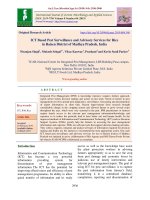
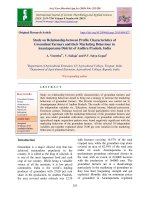
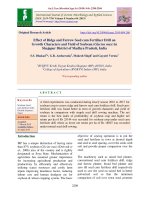
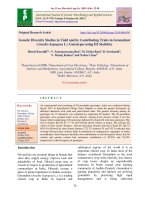

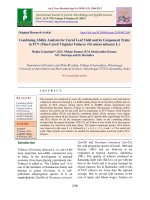
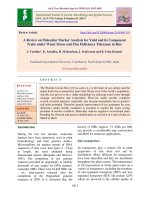

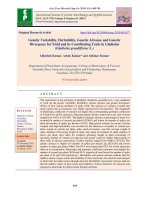
![Genetic variability studies in F2 segregating populations for yield and its component traits in Okra [Abelmoschu sesculentus (L.)Moench]](https://media.store123doc.com/images/document/2020_01/13/medium_nxs1578931693.jpg)